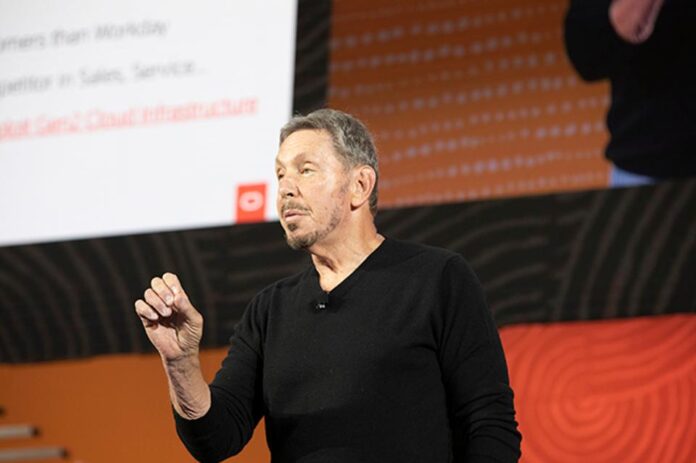Oracle is uniquely positioned for growth in the enterprise cloud application market segment, as it leverages the database, analytics, security, integration, and extensibility capabilities of its underlying Oracle Generation 2 Cloud Infrastructure, Chairman and CTO Larry Ellison said during his second keynote at Oracle OpenWorld.
Oracle, which started rewriting all of its on-premises applications for the cloud a dozen years ago, already is the #1 provider of cloud-native ERP and human resources apps and the #2 provider of cloud-native customer experience (CX—sales, marketing, customer service, and commerce) apps, Ellison said. In total, Oracle has more than 31,000 cloud application customers, he said.

Meantime, Oracle’s main application competitors—SAP and Workday in financials, Workday in HR apps, and Salesforce.com in CX—are limited by their lack of a robust cloud infrastructure layer, Ellison said during his September 18 keynote. On the flip side, of Oracle’s four main cloud infrastructure competitors—Amazon Web Services, Microsoft, Google, and IBM—only Microsoft has a portfolio of cloud enterprise applications.
In cloud financials/ERP, the largest but least mature enterprise cloud application sector, Oracle has about 25,000 customers for its Fusion and Oracle NetSuite apps, compared with a few hundred for Workday, Ellison said.
SAP, Oracle’s biggest competitor in the on-premises ERP sector, acquired several cloud applications companies over the years “but somehow forgot to rewrite their applications for the cloud,” he said. Instead, SAP focused on developing a database, called Hana, to compete with Oracle’s leading database, Ellison said, effectively telling customers: “We want you to move to the same old applications you had before, but now they’re running on Hana,” he said “…They don’t have cloud ERP applications, and they certainly don’t have a cloud platform. We think that’s a huge opportunity for us. Thank you, SAP, for doing that.”
Innovations Abound
Oracle has more cloud applications with more features than any other enterprise application provider—cloud or on premises, Ellison said.
The company continues to innovate, at both the application and infrastructure levels.
It announced at Oracle OpenWorld new cloud-based process, project, and mixed-mode manufacturing applications; new machine-learning-based digital assistant functionality in its cloud ERP, HR, and CX applications; an offering called CX Unity that combines internal and third-party data about customers; new analytics capabilities, including a data warehouse that lets customers run analytics on their Fusion application data combined with outside data sources; integration of its Eloqua B2B marketing and Data Fox real-time business intelligence systems; and a modernized user interface, called Redwood, that the company will roll out across all of its cloud applications.

All of the company’s applications are either running on, or in the process of being moved to, the self-patching, self-tuning, self-updating Oracle Autonomous Database, Ellison said.
Even very large companies are shedding any lingering doubts they have about moving to cloud-based applications.
“This is no longer early days,” he said. “This is a period we’re seeing of sudden acceleration, as we see customers wanting to modernize their systems, wanting to modernize their business practices, moving from older systems to modern cloud systems. And again, we think [it’s] a gigantic opportunity for us.”
Among Oracle’s largest cloud application customers—some of which weren’t on-premises E-Business Suite customers—are AT&T, Cox Communications, HSBC, Wells Fargo, Ford, BMW, Mack Trucks, McKesson, Duke University, Cummins, and Major League Baseball.
“The rate at which these systems are going in—from the time you sign the contract to the time you go live—is not lots of years. Now it’s lots of months,” he said. “Big difference from the systems that came before. Even our systems—[they go] in much more quickly for much less money than our earlier on-premises systems.”

